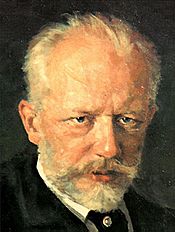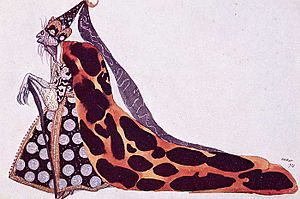The Sleeping Beauty (ballet) facts for kids
| Tchaikovsky's Ballets |
|---|

Swan Lake (1877) |
The Sleeping Beauty (Russian: Спящая красавица, tr. Spyashchaya krasavitsa) is a famous ballet with music by Pyotr Ilyich Tchaikovsky. He finished composing it in 1889. It is the second of his three ballets and one of his longest works.
The story for the ballet was created by Ivan Vsevolozhsky, based on Charles Perrault's fairy tale La belle au bois dormant. The first person to arrange the dances (the choreographer) was Marius Petipa. The ballet first opened at the Mariinsky Theatre in St. Petersburg, Russia, on January 15, 1890. Since then, The Sleeping Beauty has become one of the most well-known ballets in the world.
Contents
History of the Ballet
In 1888, Ivan Vsevolozhsky, who was in charge of the Imperial Theatres in St. Petersburg, asked Tchaikovsky to create a new ballet. They first thought about the story of Undine. But later, they decided to use Charles Perrault's La Belle au bois dormant instead. Tchaikovsky was happy to take on the job, even though his first ballet, Swan Lake, was not very popular at first.
Tchaikovsky used the Brothers Grimm's version of the story, called 'Dornröschen'. In that version, the Princess's parents wake up after 100 years to celebrate her wedding. However, Vsevolozhsky added other characters from Perrault's stories into the ballet. These included Puss in Boots, Little Red Riding Hood, Cinderella, and Bluebird. Tchaikovsky was very inspired by the story and enjoyed working on the music.
Marius Petipa, the ballet master of the Imperial Ballet, was the choreographer. He gave Tchaikovsky very detailed instructions for the music. Tchaikovsky worked quickly, starting his first ideas in late 1888 and beginning to write the full music for the orchestra in May 1889.
The ballet focuses on two main opposing forces: good, represented by the Lilac Fairy, and evil, represented by Carabosse. Each of them has a special musical theme, called a leitmotif, that plays throughout the ballet. This helps tell the story. However, the third act of the ballet is different. It focuses on the dances of various fairy tale characters at the royal wedding.
When The Sleeping Beauty first opened, it received better reviews than Swan Lake. Sadly, Tchaikovsky passed away in 1893, so he never saw how successful his ballet would become outside of Russia. By 1903, The Sleeping Beauty was the second most popular ballet performed by the Imperial Ballet. It had been performed 200 times in just 10 years.

A performance in Milan, Italy, did not get much attention. But in 1921, in London, the ballet finally became very popular. It then earned a lasting place in classical ballet. In 1999, the Mariinsky Ballet recreated the original 1890 production. They even made copies of the original sets and costumes.
The Sleeping Beauty is Tchaikovsky's longest ballet. It can last almost four hours if performed completely, including breaks. The music itself is nearly 3 hours long. It is almost always shortened for performances today.
At the first performance, Tsar Alexander III called Tchaikovsky to his special box. The Tsar simply said, 'Very nice.' Tchaikovsky was a bit annoyed, as he probably hoped for more praise. But the Tsar did give Tchaikovsky a large bonus payment right away.
Key Performances
St. Petersburg Premiere (World Premiere)
- Date: January 15, 1890
- Place: Imperial Mariinsky Theatre, St. Petersburg
- Balletmaster: Marius Petipa
- Conductor: Riccardo Drigo
- Original Cast: Carlotta Brianza as Princess Aurora, Marie Petipa as the Lilac Fairy, Enrico Cecchetti as Carabosse and Bluebird, Pavel Gerdt as Prince Désiré.
Moscow Premiere
- Date: January 17, 1899
- Place: Moscow Imperial Bolshoi Theatre
- Balletmaster: Aleksandr Gorsky
Other Important Productions
- 1921, London, Alhambra Theatre: This production, called The Sleeping Princess, was put on by Sergei Diaghilev. It helped the ballet become famous in the Western world.
- 1946, London, Royal Opera House: Performed by the Sadler's Wells Ballet, this helped establish the ballet in the UK.
- 1999, St. Petersburg, Mariinsky Theatre: This production by Sergei Vikharev tried to recreate the original 1890 show using old notes and designs.
Story of The Sleeping Beauty
Setting
- Time: The Baroque period (1600s-1700s)
- Place: Europe

Prologue — The Christening of Princess Aurora King Florestan XXIV and his Queen celebrate the birth of their first child, Princess Aurora. Six good fairies are invited to give gifts to the baby princess. Each fairy gives her a good quality, like beauty, courage, or musical talent. The most powerful fairy, the Lilac Fairy, arrives last. But before she can give her gift, the evil fairy Carabosse bursts in with her helpers.
Carabosse is furious because she was not invited to the christening. The Master of Ceremonies, Catalabutte, is blamed. Carabosse curses the baby princess: Aurora will grow up to be beautiful, but on her sixteenth birthday, she will prick her finger on a spindle and die. The King and Queen are terrified.
However, the Lilac Fairy steps in. She cannot completely remove the curse, but she can change it. Instead of dying, Aurora will fall into a peaceful 100-year sleep. She will only wake up when a handsome prince kisses her. Everyone is relieved that Aurora's life will be saved. The Lilac Fairy then casts a spell to make the whole kingdom sleep when Aurora does.
Act I — Princess Aurora's Four Suitors It is Princess Aurora's sixteenth birthday. Celebrations are happening, but the King is still worried about Carabosse's curse. The Master of Ceremonies finds some peasant women knitting, which is forbidden because of the spindle curse. The King wants to punish them, but the Queen convinces him to be kind.
Princess Aurora arrives and dances with four princes who want to marry her. This famous dance is called the Rose Adagio. Suddenly, a mysterious cloaked stranger appears and offers Aurora a gift: a spindle. Aurora has never seen one and is curious. She pricks her finger, just as Carabosse predicted. She seems fine at first, but then she faints and falls to the ground.
The stranger reveals herself to be Carabosse, who thinks her curse has worked and the princess is dead. But the Lilac Fairy calms everyone down, reminding them that Aurora is only asleep. The princess is carried to her bed. The Lilac Fairy then puts the entire kingdom to sleep. Thick thorny plants grow around the palace, hiding it from view.

(Mariinsky Theatre, St. Petersburg)
Act II, Scene I — Prince Désiré's Hunt One hundred years later, Prince Désiré is on a hunting trip. He is sad and asks to be left alone. In the forest, he meets the Lilac Fairy. She has chosen him to awaken Aurora. She shows him a vision of the beautiful princess, and the prince immediately falls in love. The Lilac Fairy explains the situation, and Désiré begs her to take him to the princess.
The Lilac Fairy leads him to the hidden castle. Carabosse tries one last time to stop them, but the Lilac Fairy and the prince work together to defeat her.
Act II, Scene II — The Sleeping Castle Inside the castle, Prince Désiré wakes Aurora with a kiss. The rest of the court also wakes up. The King and Queen are very happy when the prince asks Aurora to marry him, and she agrees.
Act III — The Wedding of Désiré and Aurora The royal wedding is taking place. Guests include the Jewel Fairies (Diamond, Gold, Silver, and Sapphire) and, of course, the Lilac Fairy. Many other fairy tale characters are also there, like Puss in Boots and The White Cat, and Princess Florine and the Bluebird.
Aurora and Désiré perform a grand dance together, called a Pas de Deux. The entire group then dances. The prince and princess are married, and the Lilac Fairy blesses their union.
Main Characters
- King Florestan XXIV
- Queen
- Princess Aurora (The Sleeping Beauty)
- Catalabutte (the Master of Ceremonies)
The Fairies
- The Lilac Fairy (the good fairy)
- Carabosse (the evil fairy)
- Other good fairies: Candide, Coulante, Miettes qui tombent, Canari qui chante, Violente
- The Gold, Silver, Sapphire, and Diamond Fairies
The Four Suitors
- Prince Chéri
- Prince Charmant
- Prince Fortuné
- Prince Fleur de Pois
The Prince's Hunting Party
- Prince Désiré (also called Florimund)
- Gallifron (Prince Désiré's tutor)
Fairy-Tale Characters
- Puss-in-Boots
- The White Cat
- Cinderella
- Prince Charming
- Princess Florine
- Bluebird
- Little Red Riding Hood
- The Gray Wolf
- Hop-o'-My-Thumb, his brothers, and the Ogre
Music and Instruments
The music for The Sleeping Beauty is played by a large orchestra. Here are some of the instruments Tchaikovsky used:
- Woodwinds: Flutes, Piccolo, Oboes, Cor anglais (English horn), Clarinets, Bassoons
- Brass: Horns, Cornets, Trumpets, Trombones, Tuba
- Percussion: Bass Drum, Cymbals, Glockenspiel, Side Drum, Tambourine, Tam-tam, Timpani, Triangle
- Keyboards: Piano
- Strings: Harp, Violins, Violas, Cellos, Double basses
Images for kids
-
Alexandra Ansanelli as Princess Aurora and David Makhateli as Prince Florimund in a Royal Ballet production of Sleeping Beauty, 29 April 2008.
-
The Bluebird and Princess Florina (Valeri Panov and Natalia Makarova) from the 1964 Russian motion picture featuring artists of the Kirov Ballet.
See also
 In Spanish: La bella durmiente (ballet) para niños
In Spanish: La bella durmiente (ballet) para niños



